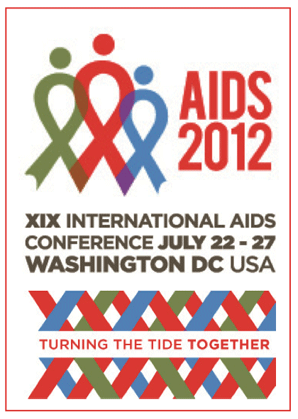19th IAS World AIDS Conference, 22–25 July 2012, Washington
1 August 2012. Related: Conference reports, Conference index, World AIDS 19 Washington 2012.
 Over the last decade, the International AIDS Society (IAS) World AIDS Conference has increasingly focused on social rather than scientific aspects of HIV and this trend continued this year.
Over the last decade, the International AIDS Society (IAS) World AIDS Conference has increasingly focused on social rather than scientific aspects of HIV and this trend continued this year.
About 85% of over 3000 studies and presentations were on human rights, funding, access, policy, prevention, access to care and issues of stigma. The majority of clinical studies were posters (a summary presented on a 2 x 1 metre display) and this year, only 25 posters each day focused on early or basic science (Track A) and less than 75 on clinical studies (Track B). From over 80 hours of podcasts only five sessions were focused on treatment.
So although the important clinical studies are reported below, the web casts on the social, political and human rights aspects provide the context for the main meeting. The panelists and speakers in many of these sessions sometimes provide more insight into some settings than a test tube or statistical calculation.
More than 20,000 delegates attend, but within a few hours of the closing sessions the halls empty and the venue prepares for computer games (where IAS stands for Increased Attack Speed), or life empowerment, booked for the following week. And it becomes easier to distill the point of the activity and expense.
With this more than other medical conferences, certain issues usually come to represent the meeting rather than headline results based on new scientific advances. Remembering the impossibly slow progress of the “3×5” campaign (3 million people on treatment by 2005), this conference, with its shift to focus on treatment access has sailed past this once-daunting goal.
So this year the conference marked the time when more than eight million people in low and middle-income countries are able to access and remain on treatment. And although the media focus was “Turning the Tide Together”, achieving 8 million people on treatment is probably a more tangible focus.
Programme strengths this year included:
A platform for speeches
On policy and access, and for HIV positive people and activists leading many of the community responses to give their diverse perspectives on a world stage.
Asserting the focus on a cure
Many sessions included early research connected to a cure, including a pre-meeting workshop.
Clinical data
Highlights included new drugs for HIV and TB, children’s health and other studies.
HIV prevention
With an emphasis this year focusing on policy and implementation rather than new clinical data. This especially focused on Treatment as Prevention (TasP), PrEP, circumcision, needle-exchange, and infant and maternal access to treatment.
HIV and long-term health
The increasing focus on inflammation as a concern, overlapping with ageing and use of earlier treatment.
To launch publications and reports
Many publications contain more detail and planning that could fit into a single symposium or poster, and most are available free online.
Other community events
The conference incuded a “Global Village” for many community events. This year, more than 50,000 quilts hung in the conference halls and laid out along part of the National Mall Park near the Washington Memorial and 50 other locations in Washington.
Reports in this issue of HTB include:
- IAS: social and political talks online as webcasts
- New booster – cobicistat as an alternative to ritonavir
- Dolutegravir vs raltegravir in treatment-naive patients: 48 week results from the SPRING 2 study
- Elvitegravir vs raltegravir: 96 week phase 3 results in treatment experienced patients
- In vitro and animal data support safety profile of BMS 986001: d4T-like NRTI currently in clinical trials
- Switching to rilpivirine/tenofovir/FTC fixed dose combination from boosted-PI regimen: SPIRIT study draws the line at 24 weeks
- Maraviroc plus atazanavir/ritonavir in a nuke-sparing regimen in treatment-naive patients
- Five-year results with raltegravir in naïve and experienced patients
- First report: atazanavir-related gallstones (cholelithiasis)
- Paediatrics studies at 19th International AIDS Conference and the 4th International Workshop on HIV Pediatrics
- Novel lopinavir/ritonavir sprinkle formulation for children in resource-limited settings
- Update on new antiretrovirals for children and adolescents
- Tenofovir prophylaxis for neonates
- Efavirenz levels variable in children in the CHAPAS-3 study
- Early initiation of ART is associated with growth recovery in children in NEVEREST-2
- High prevalence of peripheral neuropathy in children taking d4T in rural South Africa
- Lipid profile in children in PREDICT: immediate versus deferred nevirapine-based ART
- High levels of maraviroc in rectal tissue fail to protect macaques from SIV transmission following rectal exposure
- Mechanisms for circumcision to reduce HIV transmission in different penile tissue: target cell differences rather than keratinisation
- Towards an HIV cure: Early developments in the field
- Launch of publications during IAS

